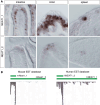Paraspeckle nuclear bodies--useful uselessness?
- PMID: 22476590
- PMCID: PMC3428521
- DOI: 10.1007/s00018-012-0973-x
Paraspeckle nuclear bodies--useful uselessness?
Abstract
The nucleus of higher eukaryotes, such as humans and mice, is compartmentalized into multiple nuclear bodies, an organization that allows for the regulation of complex gene expression pathways that are characteristic of these organisms. Paraspeckles are recently discovered, mammalian-specific nuclear bodies built on a long, non-protein-coding RNA, NEAT1 (nuclear-enriched abundant transcript 1), which assembles various protein components including RNA-binding proteins of the DBHS (Drosophila behavior and human splicing) family. Paraspeckles have been proposed to control several biological processes, such as stress responses and cellular differentiation, but their function at the whole animal level remains unclear. In this review, we summarize a series of studies on paraspeckles that have been carried out in the decade since their discovery and discuss their physiological function and molecular mechanism.
Figures




References
-
- Platani M, Lamond AI (2008) Nuclear organisation and subnuclear bodies. In: RNA trafficking and nuclear structure dynamics. Progress in molecular and subcellular biology, vol 35. Springer, Berlin, pp 1–22 - PubMed
Publication types
MeSH terms
Substances
LinkOut - more resources
Full Text Sources
Other Literature Sources

